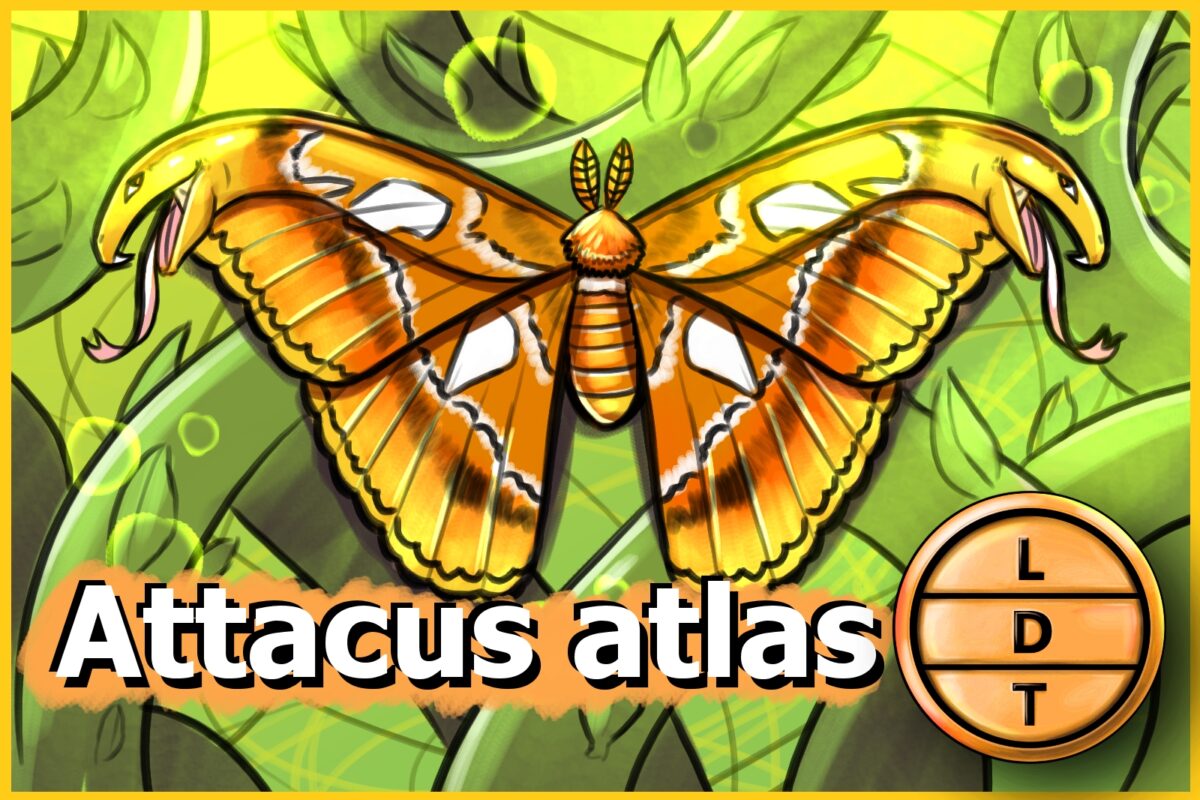“…and today we’re talking about an insect that wants you to think it floats like a butterfly and stings like a bee.”
What would you do if you only had energy from the food you ate when you were a kid? You may move as little as possible, and only when you had to. That’s what the Atlas moth does, since it doesn’t have a mouth designed for eating food. But what does it do when predators show up looking to snack on a gentle, defenseless, insect? Sometimes a bluff goes a long way in Life, Death, and Taxonomy.
Description
- As a caterpillar, atlas is green with spines that are white and waxy – like the Jimmy Fallon exhibit at madame tussauds
- Their cocoons look like brown dried leaves – mostly because they are dried leaves
- Once they become moths (or the imago stage), they have large rust red wings with cream-colored tips that have no other interesting design features whatsoever
- Their wings also have fang or claw-shaped patterns on each side.
- Their bodies are also rust-colored with cream-colored stripes.
- They have long, feathered antennae that look a lot like the sea pen that are very sensitive chemoreceptors
Measure Up
Welcome to the beloved Measure Up segment. The official listener’s favorite part of the show! The part of the show when we present the animal’s size and dimension in relatable terms through a quiz that’s fun for the whole family. It’s also the part of the show that’s introduced by you when you send in audio of yourself saying, singing, or chittering the words Measure Up into ldtaxonomy at gmail dot com.
- Moose
- Mouse
- Mink
- Skink
Wingspan
- 24 cm (9.4 in)
- How many atlas moths go into the height of the smallest elephant in the world?
- Hint: The Borneo Pygmy elephant is native to forests of Malaysia. It’s the fourth officially recognized subspecies of Asian elephant.
- 7 moths. 1.7 m (5 ft 6 in)
Larva Length
- 11.5 cm (4.5 in)
- How many moth larvae go into the height of the tallest living tropical tree?
- Hint: The tree was found in Borneo via a flyover. In 2019, the tree was climbed and measured. It’s a species of yellow meranti.
- 857 larvae. The tree is 98.53 m (323 ft 3.1 in) tall.
Fast Facts
- Range: South, East, and Southeast Asia from the Stans to Japans
- They like forests and shrublands
- Diet:
- As caterpillars they eat leaves, unsurprisingly. They primarily eat citrus, cinnamon, guava, and evergreen leaves. Though they eat their egg shell first after hatching.
- As full-blown moths, their diet gets very interesting – and by interesting I mean nonexistent.
- They don’t have developed mouthparts so they can’t eat as adults. So they live for just a couple of weeks while they look for a soulmate
- They live and love off of the fat they stored up as a caterpillar
- Behavior:
- When the caterpillar gets to max length (4.5”) they spin a cocoon out of silk and dry leaves and live in it for a month before emerging as adult moths with the world on their shoulders
- Because of the fact that they can’t eat, they need to conserve energy
- Each flight can take literal days off of their life
- So females hang out pretty close to their cocoons and release hormones into the air currents to attract males to them. This way, she can always have enough energy to lay her eggs once they’re fertilized.
- May have been the inspiration for the legendary monster Mothra
- The males have antennae that are so sensitive that they can detect a few molecules of female pheromone in the air.
Major Fact: Snake in the Grass
Atlas moths are large insects, but they are delicate and vulnerable to fast moving predators. When flight can’t carry them to safety, they have to rely on something else to avoid becoming lunch.
Atlas moths have extensions on the tips of their forewings that look incredibly like snake heads. I don’t mean it’s sort of like the size and shape of a snake head. There is countershading, a black spot for an eye, and a line for a mouth.
Of course, having the appearance of a snake is great for smaller predators, but there’s probably several birds and mammals that wouldn’t mind chowing down on a snake either. But the Atlas moth doesn’t just look like any snake. It’s coloration and shape makes it look like a cobra.
Borneo is a tropical paradise and home to many reptiles, including the Malayan spitting cobra. This cobra’s venom is extremely venomous, including neurotoxins and cardio toxins, which means it damages your brain and heart. The toxin has an LD50 in mice of 0.5 micrograms. Most animals stay far away from it.
When the moth is threatened it will land and start fanning it’s wings to appear as snake-like as possible. There’s a picture of them on a tree branch and it straight up looks like a coil of several snakes.
Ending: So eat your eggs, stay beautiful, and keep your snake hands to yourself like the atlas moth here in LDT.

